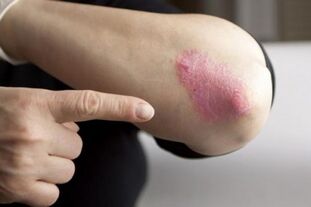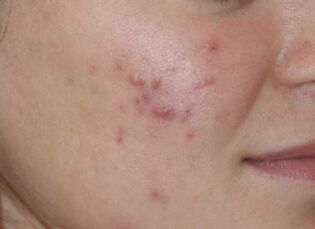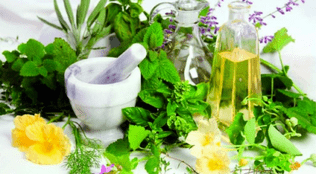In this article, we will look at the early stages of psoriasis, its causes and the mechanism of damage zones. By following our recommendations, you can recognize the symptoms of psoriasis at an early stage and eliminate them.
Early signs of psoriasis
Patients may have different symptoms of psoriasis. The disease is characterized by an acute onset, rashes occur for a short time. The main rash is also called duty or protective rash.
The initial phase lasts several weeks. The duration of this stage of the disease depends on the general condition of the body and its protective capacity.
The rash consists of small papules (pimples) ranging from pale pink to red on the skin. They are dense to the touch.
After a while, you will find easily removed silver-white scales. The skin of the affected areas becomes inflamed, swollen and red.
Experts identify 3 features of psoriasis that distinguish it from other diseases:
| Feature | Feature |
| Stearin stain. | This is a board with crumbs that look like small scales. |
| Psoriatic film. | The last layer that can be removed from the skin after the scales. This layer looks like a plastic cover. |
| Blood clot or Auspitz phenomenon. | Appearance of blood droplets that disrupt the integrity of the psoriatic film. |
Spills have different shapes: dot, drop-shaped, coin-shaped, ring-shaped, scattered.
In addition to the rash, the patient is concerned about peeling, redness, itching of varying intensity.
Psoriasis on the elbows

Plaque psoriasis is characteristic of the elbow area. At first, only red papules appear. Then the skin begins to peel and become rough.
Psoriasis of the legs
Early signs: a small rash, inflammation and swelling of the skin. Typical localization: knees and feet. Over time, the skin peels and the disease begins to progress.
Psoriasis on the hands
The first papules are found in the extensor part of the joints (fingers and elbows). Very often rashes occur on the palms with foot lesions. Sometimes psoriatic arthritis occurs. Affects joints of different sizesIt is characterized by swelling, redness and deformity of the joint, painful sensations may be disturbing.
Psoriasis on the nails
The appearance of the disease on the nail plate is similar to a fungal infection. Initially, longitudinal grooves and dents appear on the edge of the nail. Over time, the process approaches the root zone of the nail. The nail freezes and thickens. As the disease progresses, the nail may rupture.
Psoriasis in the head
Localization of the rash: anterior part, behind the ears and neck. Papular eruptions are accompanied by scaling and itching. Damaged areas often get wet and crack. A characteristic symptom is "psoriatic crown". Rash occurs when hair growth goes beyond.
Psoriasis on the face
The disease rarely affects the front of the head. Localization of the rash: in the form of a thin mesh on the eyelids, nasolabial folds, around the eyes, eyebrows, cheeks.

Features of the initial stage of psoriasis in children
To diagnose psoriasis in a child, first of all it is necessary to see small pimples (papules) with redness and irritation in the areas of redness and friction between the wrinkles of the skin. The child is worried about itching and burning.
You should know! Early stage of psoriasis in infants without proper examination can be confused with allergic manifestations, diathesis, prickly heat, diaper dermatitis. A distinctive feature of psoriasis is that it has a clear border.
It should be noted that congenital psoriasis in children is characterized by more pronounced clinical manifestations from birth.
Children with weakened immunity after a severe infection are at risk for psoriasis. Special attention should be paid to children whose parents have psoriasis.
Mechanism of psoriatic plaque formation
Psoriasis spots are places where an inflammatory reaction occurs and excessive formation of keratinocytes (epithelial cells) occurs. In this case, an excessive number of capillaries are formed in the dermis. Infiltration (wetting) of damaged skin with lymphocytes and macrophages causes it to thicken and rise. The result is pale gray spots that look like hardened wax.
Important! Normally, the epidermis is renewed every 30 days. With psoriasis, the duration of this period is significantly reduced. In this disease, cell division, maturation and death occur in just 5 days. Due to the pathological speed, the connection between the cells is broken.
Causes
Experts identify several motivating factors:
- Hereditary predisposition.It is believed that a genetic defect has occurred in the human body and causes an increase in keratinization.
- Immune system disorders,cause an increase in lymphocytes (T-cells) and inflammation. An autoimmune reaction is not ruled out - damage to its own cells and tissues as a result of being perceived as a foreign cell.
- Endocrine pathology,metabolic diseases.
- Diseases of the nervous system.
- Excessive psycho-emotional stress, stress.This factor is a provocateur that causes the disease to develop and at the same time contributes to its exacerbation. In a stressful situation, the body releases hormones and a number of biochemical reactions, which lead to the formation of rashes and scales.
- Alcohol,drugs, smoking tobacco products.
You should know! Children whose parents have psoriasis have an increased risk of developing the disease.
Diagnostics
If you suspect psoriasis, consult a dermatologist. As a rule, a diagnosis is made after an external examination and assessment of the condition of the damaged skin areas. In rare cases, if there are doubts and difficulties in the diagnosis, the doctor prescribes additional research methods. These include:
- Skin biopsyis a procedure for sampling damaged skin. Helps identify changes at the cellular level.
- Blood test.Helps detect inflammation and rule out other diseases.
- X-ray of the joints.Used only for joint pain to rule out the development of psoriatic arthritis.
- bacteriological culture from the pharynx. It is prescribed to confirm the form of psoriasis in the form of tears and to exclude acute pharyngitis.
- Potassium hydroxide test.Helps eliminate fungal infections.
Disease Treatment
Unfortunately, there is no cure for the disease today. Therefore, the main goal of therapy is to eliminate the symptoms and eliminate relapses with an increase in remission time (time interval for the weakening and disappearance of symptoms of the disease). Therefore, treatment should be extensive and long-term.
After diagnosing, determining the stage and severity of the disease, the dermatologist selects the necessary treatment methods. Before starting therapy, the patient's diet and lifestyle are adjusted. All possible factors that aggravate the disease are absolutely excluded.
At the initial stage, the doctor may prescribe the following:
| group of drugs | name of the drug | Expected effects and treatment features. |
| Keratolytics | Betamethasone. | improves wear. |
| Vitamins | Derivatives of vitamin D3 or A. | Improves the overall condition of the body and skin. |
| Local non-hormonal drugs with anti-inflammatory effect | Clemastine, Promethazine hydrochloride. | Eliminate inflammation, redness, swelling. |
| resin ointments | coal tar oil extract | Improves healing. |
| Solidol-containing products | Has a positive effect on healing, eliminates itching. | |
| Salicylic acid ointments | Salicylic acid | Accelerate healing and help the crust grow. |
Do not use aggressive drugs in the early stages. Medications should be for external use, the doctor prescribes for oral administration in case of a severe course of the disease.
In addition to drug treatment, specialists prescribe physiotherapy procedures:
- UFO (ultraviolet radiation).
- Baths: paraffin, radon, sulfide.
- Hirudotherapy.
Traditional treatments
It is possible to use folk recipes for treatment at home. It should be taken only in conjunction with the main treatment prescribed by a dermatologist and only after consulting a doctor.
There are many recipes aimed at improving the general condition of the body, as well as local remedies to eliminate the external manifestations of the disease. A string, flaxseed oil, celandine, calendula ointment has a good effect.

Review the most popular recipes for alternative treatments:
Ointment for psoriasis
Contents:
- St John's wort - 20
- Bread (root grass) - 20 g.
- Propolis - 20 gr.
- Calendula -10 years
- Vegetable oil - 10 gr.
How to cook:Crush all the herbs until smooth. Then add the vegetable oil and mix thoroughly. Keep in a cool, dark place.
How to use:Lubricate the affected skin 2-3 times a day.
Result:An herbal ointment will help relieve inflammation.
Egg Ointment
Contents:
- Chicken eggs - 2 pieces.
- Sunflower oil - 1 tablespoon.
- Acetic acid - 40 g.
How to cook:Mix eggs and butter. Then add acetic acid to the resulting mass and mix well.
How to use:Lubricate affected skin once a day at night.
Result:An effective remedy eliminates the initial symptoms of psoriasis - reduces swelling, redness and helps to fade rashes.
Herbal decoction
Contents:
- scream - 10 years
- Tansy flowers - 10 years
- Chamomile flowers - 15 gr.
- Vodka - 50 g.
- sea buckthorn oil - 10 grams.
- Water - 1 glass.
How to cook:Chop all the herbs. Then pour boiling water over it and boil for 5 minutes. Then leave the water to infuse for 40 minutes. Then strain and add vodka, sea buckthorn oil and mix well.
How to use:Take broth once a day. To do this, dilute the product - 0, 3 cups 3 drops of warm boiled water. Diluted broth - 1 tbsp. l Apply to damaged skin once a day for the same amount of water.
Result:broth when taken orally eliminates rashes and inflammation - has a general strengthening effect on the body.
Diet
Proper nutrition is the key to your health. Properly selected diet will help prevent the aggravation of psoriasis. An individual meal is prepared for each patient.
Make sure you exclude from the diet:
- Alcohol and tobacco products.
- Coffee.
- Chocolate.
- Smoked meats and spicy foods.
- Preservatives and carbonated beverages.
Also limit the use of flour products and sweets.
Your diet should be complete and meet your energy needs. Nutritionists recommend including the following foods in your diet:
- fermented dairy products.
- Vegetable oils.
- Fresh vegetables and fruits.
- Porridge.
Questions and Answers
What oil is used for psoriasis?
This requires a medical solid sold in pharmacies. The agent is most effective in its pure form without any additives.
Can psoriasis be treated with traditional medicine?
It is possible, but only with traditional methods and after consulting a doctor. Salt baths have a good effect (sea salt is used). Chamomile or string bath helps relieve inflammation. Itching will help eliminate the infusion of juniper. In the early stages, rubbing with oatmeal helps to remove the crust.
Is psoriasis contagious?
Answer no: psoriasis is not contagious. The infectious origin of the disease has been completely refuted.
Pearl hair falls out?
This does not happen if psoriasis is not associated with other diseases that cause hair loss. Hair loss is not observed in most patients.
What makes psoriasis worse?
There are periods of improvement and exacerbation of the disease. Knowing the factors that aggravate the situation will increase the time when you will not have to worry about its manifestations. There are few possible causes of deterioration, so they should be considered and remembered:
- Damage and scratches on the skin.One of the most common symptoms of psoriasis is itching and burning. Scrubbing of damaged areas aggravates the situation.
- The sun's rays.Sunlight is good for sensitive skin. But at the same time, sunburn can lead to the development of psoriasis.
- Stress.Some patients report worsening psoriasis after a nervous breakdown.
- Various infections.They disrupt and weaken the body's defense system.
- Diet.A healthy and proper diet is important for the treatment of the disease. But if it is broken, patients see that their condition worsens. Especially if you consume alcohol and smoke an unlimited amount.
Can I remove the crumbs myself?
By no means! You cannot take the scales on your own. This can lead to complications and anxiety.
What to Forget
- Psoriasis is a chronic disease with periods of improvement and exacerbation.
- There is currently no cure for the disease. Treatment consists of periods of remission and increased remission (when psoriasis symptoms do not appear).
- The early stages of the disease are best treated, so if the first symptoms appear, consult a dermatologist.
- Children whose parents have psoriasis are more likely to get the disease.























